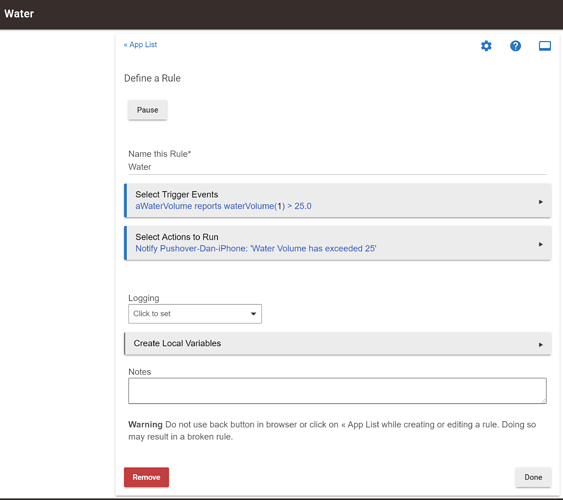I've not gone too far into Hubitat's driver development, but my guess is that it's because you don't have any "Capability" set in your driver. Capabilities pretty much define what a device is or does, and determines where and how it can be used by Hubitat. You can find the list of available capabilities at:
https://docs.hubitat.com/index.php?title=Driver_Capability_List
However, as you'll see, and as mentioned above, there isn't something like a "water volume" capability, so I'm not sure what would be the best way to go about writing a driver for this use. However, if I personally wanted to accomplish what you want, I can think of a way to do it without any custom coding.
From what I can gather, you want a way for your Pi to send updates of water volume to Hubitat. Is this the extent of the interaction you need between the two? You don't need to send data or commands from the Hubitat to the Pi? If so, I'm not seeing the need to make your Pi discoverable. Your Hubitat can receive data (eg. through MakerAPI) without really needing to know anything about the sending device.
If I just wanted to get something like this working, here's one way to go about it. Note that, as mentioned earlier, Hubitat doesn't have any in-built understanding of something like "water volume," so I would use a sort of "hacky" way of storing the values into Hubitat. Basically, we want to create a virtual device that can hold the kind of values that we want to deal with. Looking through the built-in drivers, I see one called "Virtual Illuminance Sensor" and since I know that illuminance (lux) values could be anywhere from zero up to the thousands, I think this device type will work. (Another possibility might be Power Meter) So, we'd create a virtual device using this driver, and name it something like "My Water Tank Volume". After creating and saving, you'll see that this device has a single value (Lux), and you can set that manually from the device page if you wish.
Now, modify/create your MakerAPI app instance, and select the virtual device to make it controllable. After doing this, and checking the available commands for our device, I was able to see that the command we want is "setLux," and therefore the URL we will want the Pi to send to would be:
http://[Your Hub IP]/apps/api/[Your Maker API App ID]/devices/[Device ID]/setLux/[water volume value]?access_token=[Your Token]
Your Pi just has to call that URL and the "lux" value of your virtual device will be updated in Hubitat.
Now that we have the value in Hubitat, we can use it RM. You'll just have to look for the "Illuminance" capability, and you'll find it there.
I know that it's "hacky" because your water volume is being referred to as a lux level, but if all you're wanting is to be able to use the value to trigger automations, and to graph the values over time, this should do the trick.



